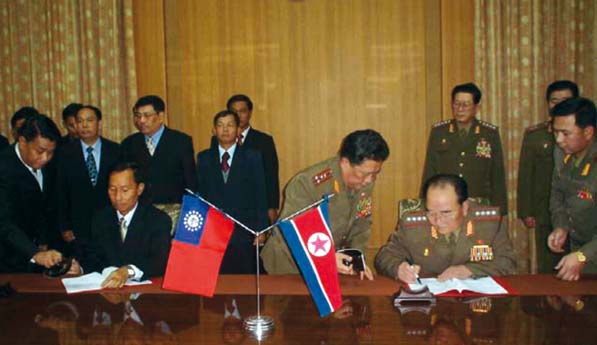Burma’s Secret Mission to North Korea

Burma’s armed forces appear to be going through a major reorganization, with sophisticated upgrades to include missiles, tunnel complexes, defensive rockets, anti-aircraft radar and command and control facilities
GEN Thura Shwe Mann, the Burmese regime’s No 3 man, made a secret visit to North Korea in November 2008.
As chief of staff of the army, navy and air force, and the coordinator of Special Operations, he led a 17-member, high-level delegation on a seven-day visit to Pyongyang, visiting, among other sites, secret tunnel complexes built into the sides of mountains to store and shield jet aircraft, missiles, tanks and nuclear and chemical weapons.
Accompanied by air defense chief Lt-Gen Myint Hlaing, Lt-Gen Hla Htay Win, Maj-Gen Khin Aung Myint, Maj-Gen Thein Htay, Maj-Gen Mya Win and senior officials from heavy industries, the delegation was clearly on a mission to cement stronger military ties with the reclusive, hermit state.
On November 27, Shwe Mann and his North Korean counterpart, Gen Kim Kyok-sik, signed a memorandum of understanding, officially formalizing military cooperation between Burma and North Korea.
North Korea will reportedly build or supervise the construction of some Burmese military facilities, including tunnels and caves in which missiles, aircraft and even naval ships could be hidden. Burma will also receive expert training for its special forces, air defense training, plus a language exchange program between personnel of the two armed forces.
It is reported that as early as 2002-3, Burma began constructing underground tunnels and caves to hide and protect aircraft and weapons, as well as to house a central command and control facility.
During his seven-day visit, Shwe Mann visited radar and jamming units in Myohyang, a highly sophisticated anti-aircraft unit, air force units and a computerized command control system in Pyongyang.
The delegation also visited a surface-to-surface (SCUD) missile factory, partially housed in tunnels, on the outskirts of Pyongyang to observe missile production.
The SCUD-D missile, with a range of 700 kilometers, and SCUD-E missile, with a range of 1,500 kilometers, could easily intimidate Burma’s neighbors, including Thailand. It is believed that Burma already has deployed six radar air defense systems along the Thai-Burmese border.
During the visit, the Burmese were also particularly interested in short-range 107 mm and 240 mm multi-rocket launchers—a multi-purpose missile defense system that could be used in case of a foreign invasion, analysts said.
Also of great interest was the latest in anti-tank, laser-guided missile technology that can be deployed within an infantry division. (As this issue goes to press, a North Korean ship, the Kam Nang 1, believed to be carrying weapons of some type, is due to dock in a Burmese port. The same ship made a mysterious port call to Burma in 2007.)
Historically, Burma has procured small arms, jet fighters and naval ships from the West, namely the US, Britain and some European countries. But after brutally crushing the 1988 democracy uprising, it faced Western sanctions and Burmese leaders desperately looked for new sources of weapons and ammunition to modernize its armed forces. Over the last two decades, Burma has bought jet fighters and naval ships from China, but increasingly it’s looked for alternative sources because of low quality and poor after-sales service. Burma has also bought jet fighters, arms, ammunition and hardware from Russia, Pakistan, India and Eastern European countries.
In the past, Burma purchased a “Pechora” air defense system—a Russian-made, surface-to-air, anti-aircraft system. Analysts say that Russians have also provided technical training and language courses to Burmese technicians.
The Burmese junta is clearly on a new mission to strengthen its military capacity, while earmarking its precious foreign reserves not to aid the people, but on more and more sophisticated weapons.
The Irrawaddy has extensive coverage of the Burma-North Korea issue at www2.irrawaddy.com.
|
||
|
||
|
||
|
||
